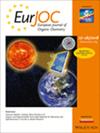Exploring the Chemical Reactivity of Triisopropylsilyl Dialkynylmethanol for the Synthesis of Dialkynylcarbinol‐Related Compounds
IF 2.7
3区 化学
Q2 CHEMISTRY, ORGANIC
引用次数: 0
Abstract
Prompted by the pharmacological relevance of lipidic alkynylcarbinols, 1‐(triisopropylsilyl)penta‐1,4‐diyn‐3‐ol is exploited as a versatile C5 organic framework. Selective functionalization of this dissymmetrical dialkynylcarbinol precursor is achieved via the creation of either a Csp–Csp (alkyne), a Csp–Csp探索三异丙基硅基二炔基甲醇合成二炔基甲醇相关化合物的化学反应性
由于脂质炔基醇的药理学相关性,1‐(三异丙基硅基)戊- 1,4‐二炔- 3‐醇被开发为一种多功能的C5有机框架。这种不对称二炔基甲醇前体通过Csp-Csp(炔)、Csp-Csp2(烯和芳基)或Csp-Csp3 (RCHOH)键的形成实现了选择性功能化。研究人员获得了一系列新的外消旋HSD17B11生物活性原细胞毒性乙酰脂类,这些脂类是迄今为止最有效的,其对骨肉瘤U2OS细胞的IC50低至27 nM。点击型1,3偶极环加成,如铜催化的与长链烷基叠氮化物(CuAAC)的反应和碱促进的与脂质氧化腈的反应,首先以外消旋形式描述。以丙烯酸树脂为固定载体的CAL - B,通过动态酶解法制备1 -(三异丙基硅基)五- 1,4 -二炔- 3 -醇两种对映体。最后,在1,3‐偶极环加成反应中使用溶解样品可以得到对映体富集的环加合物,而不会对甲醇中心产生明显的外映作用。
本文章由计算机程序翻译,如有差异,请以英文原文为准。
求助全文
约1分钟内获得全文
求助全文
来源期刊
CiteScore
5.40
自引率
3.60%
发文量
752
审稿时长
1 months
期刊介绍:
The European Journal of Organic Chemistry (2019 ISI Impact Factor 2.889) publishes Full Papers, Communications, and Minireviews from the entire spectrum of synthetic organic, bioorganic and physical-organic chemistry. It is published on behalf of Chemistry Europe, an association of 16 European chemical societies.
The following journals have been merged to form two leading journals, the European Journal of Organic Chemistry and the European Journal of Inorganic Chemistry:
Liebigs Annalen
Bulletin des Sociétés Chimiques Belges
Bulletin de la Société Chimique de France
Gazzetta Chimica Italiana
Recueil des Travaux Chimiques des Pays-Bas
Anales de Química
Chimika Chronika
Revista Portuguesa de Química
ACH—Models in Chemistry
Polish Journal of Chemistry.

 求助内容:
求助内容: 应助结果提醒方式:
应助结果提醒方式:


